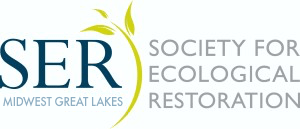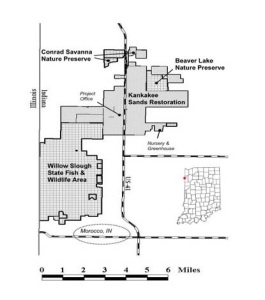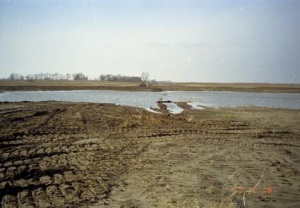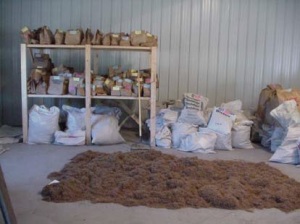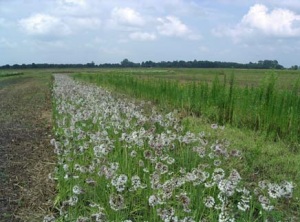Throwback Thursday – THE EFROYMSON RESTORATION AT KANKAKEE SANDS: A LANDSCAPE APPROACH FOR GRASSLAND AND SAVANNA CONSERVATION IN INDIANA
This post was initially published in September 2008.
A landscape-scale restoration project is underway in northwestern Indiana to reestablish a semblance of the original habitat mosaic at an appropriate ecological scale. The Indiana Chapter of The Nature Conservancy is attempting to reconnect and rebuild a biologically diverse landscape of over 30 square miles by reconnecting three important preserves (Conrad Savanna, Beaver Lake Prairie State Nature Preserve, and Willow Slough Fish and Wildlife Area).
We have purchased ~8,000 acres of agricultural land to reconnect these three areas. Past conservation efforts focused on each individual preserve. In contrast, the Efroymson Restoration at Kankakee Sands is designed to heal the landscape between the sites and to create a single, landscape-scale conservation area. Habitat fragmentation and isolation are thought to be the biggest threats to the long-term survival of Indiana prairie and savanna. Small, isolated prairies and barrens lose species with time, especially the rare, vulnerable and area sensitive species that most need our attention. If new colonists are not available to re-populate these sites then these areas will eventually become mere shadows of themselves — species poor relicts of a once diverse ecosystem.
The Efroymson Restoration is designed create connections that will allow these remnants to ecologically communicate with one another. What was once row crop will be transformed over time into a botanically diverse mosaic of prairie, savanna, and wetland. The development of this diverse landscape matrix will result transformation of Kankakee Sands into a viable system spanning over 20,000 acres.
Over the years we have partnered with State and Federal agencies to design and implement this ambitious restoration project. The Indiana Department of Natural Resources, National Resources Conservation Service (NRCS), and the Indiana Grand Kankakee Marsh Restoration Project assisted with the initial land acquisition. The NRCS and the Indiana Department of Environmental Management have contributed to wetland restoration work, while the Indiana Grand Kankakee Marsh Restoration Project also funded some restoration activities. The US
Fish and Wildlife Service contributed to the efforts in creating grassland and shorebird bird habitat.
The Restoration Approach
A generalized approach to prairie restoration was not sufficient because our goal is to enhance connectivity and to enable gene flow between these isolated nature preserves. We cannot scatter a generic prairie seed mix across the landscape and expect biodiversity and natural processes to be enhanced. From the onset we designed prairie and wetland community types based on soil, hydrology and ecological processes expected to occur over this variable landscape.
Restoration at the site requires managing the hydrology, botany and ecological processes.
We are modifying hydrology by creating a mosaic of soil moisture conditions, ranging from pockets of deep emergent wetlands to xeric sand rises. Additionally, the hydrology restoration is intended to optimize conditions and hydroperiods most likely to support these wet/mesic sand prairies because this habitat type has been almost eliminated from the region.
Once the hydrology is restored, appropriate native grassland and wetland communities are established by planting seeds from local genotypes. Our guiding image for botanical restoration is based on the plant communities found in adjacent high-quality natural area remnants. The initial plantings create a patchy grassland and wetland mosaic that will emulate a natural grassland mosaic. We tried to maximize the richness of the initial plantings, and have consistently seeded over 300 species each year. And the restorations will be enriched over time, such that the appropriate diversity of plants is ultimately reintroduced to each site.
In support of our restoration goals, we have established an 80-acre seed nursery at the site, designed to produce enough seed to restore approximately 640 acres per year. All nursery stock represents local genotypes, and 125 species are already in place. The nursery features a pivot irrigation system and seed processing, cleaning and storage facilities. We also wild collect seed in support of our plantings, and over 175 species are added to the nursery produced mix each year. There is also an onsite greenhouse for plug production. Species that are not well represented in seeded areas are installed as plugs. Typically, over 2,000 pounds of native seed, representing 300 to 400 species are planted in appropriate hydrological zones each year. Although there are over 100 species of grasses, rushes, and sedges in the plantings, we shy away from planting aggressive species such as big bluestem, Indian grass and switch grass that dominate most prairie plantings. We believe that by allowing the initial planting to establish with only minimal amounts of dominant grasses, we will see better establishment of the diverse prairie we are seeking to recreate.
One benefit of using high diversity plantings is the flexibility it provides for creating structural diversity. Using grasses and forbs that grow less than two feet high, we can create short stature prairie that is diverse, provides great habitat for birds and mammals needing low structure, and does not need mowing or other maintenance. Similar strategies can be used to create and sustain specialty habitats like mudflats, tall grass prairie, sparse sandy zones, and emergent wetland.
The long-term success of the Restoration depends upon re-establishing appropriate ecological processes across the site. For example, our hydrologic restorations are designed to create the seasonal shallow flooding during winter and spring, which is essential to mesic and wet prairie habitats. Similarly, prescribed fire is used to mimic the natural fires that originally would have swept through the prairie at the site. Together, the dynamic interplay of hydrology and fire over soils will create over time, the finer-scale patchiness and complexity in the restoration that will eventually allow the planting to become a natural extension of the natural areas it adjoins and protects.
Current Status
Miles of agricultural drainage ditches have been removed to create wetlands and wet prairie that are among the rarest habitat types in the region. We have now restored and planted over 5,000 acres of grasslands and wetlands at the site. The plant and animal response to the restoration has been just as exciting as all the work itself. Some restoration areas currently support over 200 species of native plants and over 400 plant species have been reintroduced as a result of our plantings. These are among the richest plant restorations in North America but at a much larger scale than other restoration projects.
 Everyone interested in conservation is aware that bird species that live in grasslands and wetlands are declining throughout Indiana and the greater Midwest in part due to habitat loss. Four of the twenty-five fastest declining bird species in North America breed in the prairie and wetlands at Kankakee Sands: Henslow’s sparrow; grasshopper sparrow; field sparrow; and northern bobwhite. Three declining species (lesser yellowlegs, king rail, and short-eared owl) rely on the site as a stopover during migration. In addition, another thirteen bird species found at Kankakee Sands are listed as threatened or endangered in Indiana. A few of these are the Northern harrier, upland sandpiper, American bittern, and black tern. In Indiana, the restoration became the first nesting location in Indiana for the Wilson’s phalarope in 50 years. In total, there have been over 200 bird species recorded on the property since 2001. Amphibians are thriving in the restoration areas as well. Since we began restoring the hydrology of the site, frogs and toads have begun breeding within the newly created wetlands. The initial response to hydrologic restoration was an almost exponential increase in breeding populations over the site. Additionally, tiger salamander larvae were documented recently as well.
Everyone interested in conservation is aware that bird species that live in grasslands and wetlands are declining throughout Indiana and the greater Midwest in part due to habitat loss. Four of the twenty-five fastest declining bird species in North America breed in the prairie and wetlands at Kankakee Sands: Henslow’s sparrow; grasshopper sparrow; field sparrow; and northern bobwhite. Three declining species (lesser yellowlegs, king rail, and short-eared owl) rely on the site as a stopover during migration. In addition, another thirteen bird species found at Kankakee Sands are listed as threatened or endangered in Indiana. A few of these are the Northern harrier, upland sandpiper, American bittern, and black tern. In Indiana, the restoration became the first nesting location in Indiana for the Wilson’s phalarope in 50 years. In total, there have been over 200 bird species recorded on the property since 2001. Amphibians are thriving in the restoration areas as well. Since we began restoring the hydrology of the site, frogs and toads have begun breeding within the newly created wetlands. The initial response to hydrologic restoration was an almost exponential increase in breeding populations over the site. Additionally, tiger salamander larvae were documented recently as well.
Initial work with insects suggests the sites are providing habitat for many rare species that were originally “trapped” on small patches of savanna and prairie. Ongoing inventory of the restoration has turned up over half of the 200 insect species that are dependent on these remnant habitat patches. We hope to see further increases in insect diversity as the fine-scale patch work of habitats coalesces across the restoration.
One rare mammal, the Great Plains Pocket Gopher, has responded dramatically to the restoration. This state imperiled species is limited to the northwest corner of Indiana, and was confined to ditch banks and a few old fields when the restoration began. The soil “push-ups” created by this burrowing mammal now dominate mesic/xeric restoration areas and newly burned fields.
Challenges
Large restoration projects pose some challenges. Certainly controlling invasive plant species tops that list – it continues to be the biggest threat to our goals. Surprisingly, the problems aren’t always from exotic species, cottonwoods and Equisetum have become as difficult to manage as the Canada thistles and Phragmites. Controlling invasives has required us to re-think staffing and prioritize follow-up management more as the restored acres accumulate.
Hydrologic performance can also be a bit unpredictable. In a natural hydrologic regime, there will be wet and dry years and this cycling is good for creating opportunities for an array of prairie plants. However, amphibians will have boom and bust years and deep-water refugia are vital to maintain some species. Waterfowl will experience the same variation in population levels to natural hydrologic cycles. We simply accept that the site will not provide perfect habitat every year.
As the restoration has proceeded, the “if you build it, they will come” model of animal recolonization has served us very well. But there are a few regionally rare species of plants and vertebrates will not be able to recolonize the site on their own. We are contemplating a program that would relocate selected species, such as ornate box turtles, to the site. In conclusion, we believe restoration sites such as Kankakee Sands offer the best long-term hope of survival for many such species in todays otherwise fragmented prairie landscape. Well-conceived large-scale restoration is
one of the key tools we have for conserving our grassland heritage for future generations.
John Shuey and Chip O’Leary, The Nature
Conservancy of Indiana
